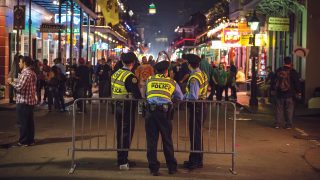
Have you attended training in traffic enforcement since leaving the police academy? It is a big topic, and traffic stops are initiated by law enforcement roughly 50,000 times daily or nearly 20 million times a year, according to data from the Stanford Open Policing Project (SOPP). The SOPP collects data on vehicle and pedestrian stops from law enforcement departments across the country.
Given discussions in some cities that traffic enforcement should be handled by non-sworn civilians, the police should be banned from making stops involving “minor” violations and that there should be greater reliance on photo radar or photo red light enforcement, now is the time for a closer look.
Who has not heard accusations of the police engaging in speed traps? Yet, there are some jurisdictions that engage in such behavior, motivated to generate revenue for their city or county. Some states outlaw speed traps by statute. Other states allow cities or law enforcement budgets to receive a high percentage of fine revenue.
The enforcement of traffic laws is primarily focused on reducing traffic collisions (and the injuries that result from them) and facilitating the safe and expedient flow of vehicular and pedestrian traffic. The primary duty of traffic enforcement should never involve a motivation for fine revenue. Traffic enforcement saves lives, reduces street disorder and plays a significant role in criminal investigations. There is also a crime deterrence and displacement value in maintaining visible traffic enforcement. These efforts result in safer roadways and streets, fewer fatalities and injuries, and less property damage.
According to the National Safety Council, traffic crashes claim at least 40,000 lives annually with at least 4.6 million injuries, so traffic enforcement is hardly an optional activity for law enforcement. Police critics will claim that vehicle stops for minor traffic infractions only exist as a pretext to interrogate the vehicle’s occupants. They also claim that officer discretion in traffic enforcement gives birth to racist practices. What truth may exist in these claims is a solvable issue without tossing this important law enforcement function out the window.
Traffic enforcement not by the police
One popular idea among some advocates of reform is to remove armed police officers from traffic enforcement and leave the task to unarmed personnel. The argument here is that, among other things, the risks to nonpolice traffic-enforcement personnel would be low.
Absent from the risk tally is an acknowledgment of the dangers averted by the presence of trained, armed officers. While it is true that most traffic enforcement involves noncriminal conduct, vehicles are common instruments and objects of crime.
Bridging the gap between investigations and patrol to focus enforcement efforts is a core element of a department’s “precision policing” strategy, which has been successful in terms of traffic enforcement. Focused enforcement involves developing and using information to ensure that enforcement is purposeful and directed to a specific crime or traffic problem.
In a 2021 Stanford Law Review paper titled “Traffic Without the Police,” University of Arkansas law professor Jordan Blair Woods writes that traffic stops “are the most frequent interaction between police and civilians today and are a persistent source of racial and economic injustice.” With over six million traffic stops being made annually across the country (according to the Bureau of Justice Statistics), there is an enormous potential for contacts to be resolved with professionality while at the same time marketing safety and prevention.
Woods proposed a framework that decouples traffic enforcement from the police. Some of the changes Woods proposed include officers no longer being able to conduct traffic stops based on minor traffic violations, or pretextual vehicle stops based on minor traffic violations. He advocates for the creation of “traffic monitors” whose authority would be limited to initiating traffic stops for traffic law violations, requesting documentation and issuing traffic citations.
Such a classroom theory of enforcement is incredibly one dimensional. Traffic enforcement is not just about minor traffic violations. The International Association of Chiefs of Police’s national law enforcement recognition program called “Looking Beyond the License Plate” kicked off in 2000, demonstrating how police officers who observe a violation and suspect that something further is wrong could lead to the apprehension of a wanted criminal or an arrest for other criminal activity.
Auto-tron enforcement
Red-light violations and speed-related technology can be easily deployed to catch offenders without bias. Automated license plate readers could be adopted for other violations, such as stop sign violations and erratic driving. Such technology sends a violation to the vehicle’s registered owner days after the violation to collect a fine or schedule a court appearance. This approach would free up officers to do other police work and reduce harsh criticism by social justice advocates and the press.
Policing solely by auto-tron photo radar machines or employing zero-tolerance police officers are both bad options. Take the human out of traffic enforcement, and you also throw discretion and common sense out of the enforcement equation, which would fly in the face of community-oriented policing.
Non-sworn Traffic Regulation Department (TRD) employees can calibrate the technology to limit court appeals. Violators can accumulate a certain number of citations before the TRD puts vehicle-disabling devices in place.
We all know that killers, burglars and drug dealers drive cars. They also speed, have broken taillights and occasionally crash. The opportunity to lawfully interact with these offenders during traffic contacts may yield the solution to many criminal offenses and the recovery of stolen property and contraband. Making the streets and highways a haven from law enforcement contacts is a license to freely operate a variety of criminal enterprises and activities. That does not even include the 1.5 million DUI arrests that were made this past year.
Looking beyond the stop
The Terrorism Screening Database, widely known as the watch list, was created in 2003 and consists of the names of people suspected of being involved with terrorism. Over the years, the list has grown to include the names of an estimated 1.2 million people, including 4,600 U.S. citizens and lawful permanent residents.
The National Crime Information Center (NCIC) provides an umbrella of data files indexing wanted persons, stolen vehicles, stolen property and much more for ready access by law enforcement to check during regular wants and warrants checks. The NCIC’s “Known or Appropriately Suspected Terrorist File” can be accessed by law enforcement during traffic stops.
The Department of Homeland Security (DHS) reports that about 4,000 known or suspected terrorists are prevented from traveling to or entering the United States each year.
According to the Federal Bureau of Investigation (FBI), law enforcement “encounters of watch listed individuals almost certainly yield increased opportunities for intelligence collection.” The FBI says such encounters could include traffic stops or domestic disputes, which gives law enforcement “the opportunity to acquire additional biographic identifiers, fraudulent identification documents, financial information and associates of watch listed individuals,” which might assist in thwarting terrorist acts.
Conclusion
Training in the specialized world of traffic enforcement, safety and prevention programming, along with crash investigation, should be offered beyond the basic academy level.
The Manhattan Institute (a New York think tank) notes that law enforcement must effectively connect traffic enforcement to crime suppression while pursuing broader public safety goals. Experience during the pandemic has revealed that removing police from traffic enforcement leads to more dangerous streets, more disorder and more crime. Any policing reforms need to be approached thoughtfully and carefully, always keeping public safety and neighborhood concerns in mind. Unfortunately, some reform proposals fail to do so; they ignore community demands and disregard officer safety. Public safety policy decisions and legislation must be informed by data and made with eyes wide open to their consequences. Otherwise, we will be left with bad policy that further endangers the community and public trust in police
institutions.
As seen in the November 2022 issue of American Police Beat magazine.
Don’t miss out on another issue today! Click below:






